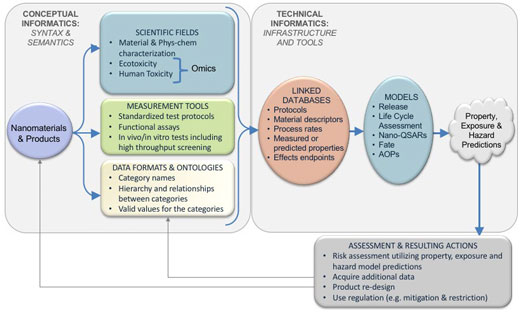| Nov 15, 2018 | |
EU US Roadmap Nanoinformatics 2030(Nanowerk News) The Nanoinformatics Roadmap 2030 (pdf) is a compilation of state-of-the-art commentaries from multiple interconnecting scientific fields, combined with issues involving nanomaterial (NM) risk assessment and governance. |
|
| In bringing these issues together into a coherent set of milestones, the authors address three recognised challenges facing nanoinformatics: | |
|
|
|
| It is also recognised that data generation will progress unequally and unstructured if not captured within a nanoinformatics framework based on harmonised, interconnected databases and standards. The implicit coordination efforts within such a framework ensure early use of the data for regulatory purposes, e.g., for the read-across method of filling data gaps. | |
 |
|
| The Nanoinformatics Roadmap: from disparate fields to an integrated infrastructure. (click on image to enlarge) | |
| As illustrated in the figure above, the scientific fields represented in this roadmap include: materials science/NM physicochemical characterisation; eco- and human toxicology (including systems biology approaches); computational modelling; and informatics. Each has its own history, precepts, test methods, analytical tools, metadata forms, ontologies, and criteria for interpreting experimental or computational results. | |
| Additionally, each has its own research community. The Nanoinformatics Roadmap adds a formal factor capturing the environment, and health and safety (EHS) data requirements (e.g., good laboratory practice) related to regulatory assessments and governance. | |
| Coordination of future research efforts and provision of a shared vision, rather than programmatic direction, is the Roadmap’s role. | |
| This roadmap has been jointly developed in trustful cooperation among scientists of the European Union, the United States of America and a few other countries. | |
| Scientists with different scientific backgrounds, working in the field of nanotechnology, have cooperated with the main objective to provide as broad an overview as possible about the young and rapidly evolving field of nanoinformatics. | |
| The main purpose of this roadmap is educational. By no means was the intention to provide all possible details. Instead, interested readers will find plenty of additional references mentioned in each of the chapters that will provide more detailed insights. |
| Source: EU NanoSafety Cluster | |
|
Subscribe to a free copy of one of our daily Nanowerk Newsletter Email Digests with a compilation of all of the day's news. |
